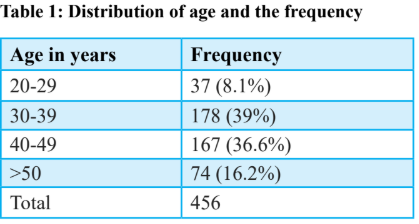Abstract
Introduction:
Cervical cancer is one of the common cancers in women and
is a major public health problem all over the world. It has
significant contribution to high mortality and morbidity. Pre-
invasive lesions spontaneously regress to normal, remain
stable for a long time or progress to higher degree of dysplasia
followed by carcinoma cervix. Materials And Method This
was a hospital based retrospective study where 456 patients’
records were reviewed. Pap smear was used as the screening
tool for the detection of precancerous lesion among the women
visiting Western Regional Hospital (WRH), Department of
obstetrics and gynecology.
Results: Among 456 patients
screened, most of them were in the age group of 30-39 years
(42.8%) and were of parity 3 (42.8%). Most of them had no risk
factors for carcinoma cervix (54.4%). Early marriage accounted
for the highest risk of developing precancerous lesion (32.7%).
There were no carcinoma detected by Pap smear. The test
was negative in 68.9%, Low-grade Squamous Intraepithelial
Lesion (LSIL) was detected in 5.9% and 2.9% had High-grade
Squamous Intraepithelial Lesion (HSIL). Pap smear was sent
for screening purpose in asymptomatic women (37.1%) and
among the symptomatic patients vaginal discharge was the
most common indication of pap test (34.6%).
Conclusion: A Pap smear is reliable, simple, non-invasive, cost effective, and
easy screening tool for detection of precancerous lesions in a
woman.
References
study in unhealthy and healthy looking cervix. J
Obstet.Gyaecol. 2007;2(2):42-7.
2. Mandakini M Patel, Amrish N Pandya, Jigna
Modi. Cervical Pap Smear Study And utility In
Cancer Screening, to specify the strategy for
Cervical cancer control. National Journal of
Community Medicine. 2011;2(1):49-1.
3. Tamrakar SR, Chawala CD. A Clinical Audit of
Pap Smear Test for screening of Cervical Cancer.
NJOG. 2012’7(2):21-4.
4. Sachan PL, Singh M, Patel ML, Sachan R. A
Study on Cervical Cancer Screening Using Pap
Smear Test and Clinical Correlation. Asia-Pacific
Journal of Oncology Nursing. 2018;5(3):337-41.
5. Makuza JD, Nsanzimana S, Muhimpundu MA,
Pace LE, Ntaganira J, Riedel DJ. Prevalence and
risk factors for cervical cancer and pre-cancerous
lesions in Rwanda. The Pan African Medical
Journal. 2015;12:26.
6. Babara L Hoffman, John O Schorge, Joseph
I Schaffer, Lisa M Halvorson ,Karen M
Bradshaw,F.Gary Cunningham. Williums
Gynecology Second edition copyright 2012 p
738-756.
7. K.S Luise,S de Sanjose,M Dias,S Castalsague,R
Herrero,C J Meijor . Early Age at First Sexual
Intercourse and Early Pregnancy are risk factors
for cervical cancer in developing countries.
British Journal of Cancer 2009; 100(7); 1191-97.
8. Qinqwe Zhang,Wenjen Xie,Feng Wang,
Pong Hong Li,Lina Cui,Huifen Wang et al.
Epidemiological Investigation and Risk Factors
for Cervical Lesion, Cervical cancer Screening
among women in rural area of Henen Province
of China. Med Sci Monit 2016; 22:1856-65;
9. Gillet E, Meys JFA, Verstraelen H, et al.
Association between Bacterial Vaginosis and
Cervical Intraepithelial Neoplasia: Systematic
Review and Meta-Analysis. Atashili J, ed. PLoS
ONE. 2012; 7(10):e45201.
10. Misra JS, Srivastava AN, Sharique A, Srivastava
KR. Cervical Cytology Associated with Pelvic
Inflammatory Diseases. J Cytol Histol. 2015;
6:343.
11. Gupta M, Sharma A, Agrawal N, Agrawal
A. Clinical Profile of Women with Postcoital
Bleeding. Santosh University Journal of Health
Science. 2016;2(2);106-8.
12. Hende Celik,Mehmetoglu Ganime,Sadikoglu,
Alis Ozcakir,Nazam Bilgel. Pap Smear Screening
in the Primary Health Care Setting Study from
Turkey. N AM Med Sci. 2010 (10) 467-472.
13. CM Das, Shah Nasreen, Ghori Ambreen, Khursheed
Farkhunda, Zaheen Zakia. Prevalence and Risk
Factors for Cervical Intraepithelial Neoplasia
in Patients attending Gynecological Outpatient
Department of Tertiary Care Hospital. Liaquat
Uni Med Health Sci. 2013; 12(1):44-8.
14. Pudasaini S, Prasad KBR. Cervical pap smear- A
prospective study in a tertiary hospital. Journal of
pathology of Nepal. 2015;5:820-23.
15. Wang Z, Wang J, Fan J, et al. Risk factors for
cervical intraepithelial neoplasia and cervical
cancer in Chinese women: large study in Jiexiu,
Shanxi Province, China. Journal of Cancer.
2017;8(6):924-932.

